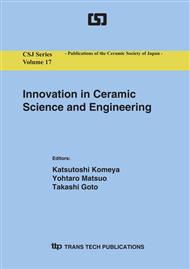[1]
E. Suvaci and G. L. Messing: J. Am. Ceram. Soc. Vol. 83 (2000), pp. (2041).
Google Scholar
[2]
K. Hirao, M. Ohashi, M. E. Brito and S. Kanzaki.: J. Am. Ceram. Soc. Vol. 78 (1995), p.1687.
Google Scholar
[3]
M. M. Seabaugh, I. H. Kerscht and G. L. Messing: J. Am. Ceram. Soc. Vol. 80 (1997), p.1181.
Google Scholar
[4]
E. Suvaci, K. -S. Oh and G. L. Messing: Acta. Mater. Vol. 49 (2001), pp. (2075).
Google Scholar
[5]
T. Takenaka and K. Sakata: Jpn. J. Appl. Phys. Vol. 19 (1980), p.31.
Google Scholar
[6]
Y. Yoshizawa, M. Toriyama and S. Kanzaki: J. Am. Ceram. Soc. Vol. 84 (2001), p.1392.
Google Scholar
[7]
T. S. Suzuki, Y. Sakka and K. Kitazawa: Adv. Eng. Mater. Vol. 3 (2001), p.490.
Google Scholar
[8]
T. S. Suzuki, H. Otsuka, Y. Sakka, K. Hiraga and K. Kitazawa : Jpn. J. Powder Powder Met. Vol. 47 (2000), p.1010.
Google Scholar
[9]
Y. Sakka and T. S. Suzuki: J. Ceram. Soc. Jpn. Vol. 113 (2005), p.26.
Google Scholar
[10]
Y. Sakka: J. Ceram. Soc. Jpn. Vol. 114 (2006), p.371.
Google Scholar
[11]
Y. Sakka, T.S. Suzuki and K. Hiraga: Key Eng. Mater. Vol. 224-2 (2002), p.619.
Google Scholar
[12]
T. S. Suzuki and Y. Sakka: Jpn. J. Appl. Phys. Vol. 41 (2002), pp. L1272.
Google Scholar
[13]
Y. Sakka, T. S. Suzuki, N. Tanabe, S. Asai and K. Kitazawa.: Jpn. J. Appl. Phys Vol. 41 (2002), pp. L1416.
Google Scholar
[14]
T. S. Suzuki and Y. Sakka: Chem. Lett. (2002), p.1204.
Google Scholar
[15]
K. Inoue, K. Sassa, Y. Yokogawa, Y. Sakka, M. Okida and S. Asai: Mater. Trans., Vol. 44 (2003), p.1133.
Google Scholar
[16]
Y. Sakka and T. S. Suzuki: Key Eng. Mater. Vol. 280-283 (2005), p.721.
Google Scholar
[17]
A. Makiya, D. Kusano, S. Tanaka, N. Uchida, K. Uematsu, T. Kimura and K. Kitazawa: J. Ceram. Soc. Jpn. Vol. 111 (2003), p.702.
Google Scholar
[18]
S. Tanaka, A. Makiya, S. Watanabe, Z.J. Kato, N. Uchida and K. Uematsu: J. Ceram. Soc. Jpn. Vol. 112 (2004), p.276.
Google Scholar
[19]
T. S. Suzuki and Y. Sakka: Scripta Mater., Vol. 52 (2005), p.583.
Google Scholar
[20]
C.Y. Wu, S.Q. Li, K. Sassa, Y. Sakka S. Suzuki and S. Asai: ISIJ Inter., Vol. 45 (2005), p.997.
Google Scholar
[21]
K. Iwai, J. Akiyama, M.G. Sun and S. Asai: Sci. Technol. Adv. Mater. Vol. 7 (2006), p.365.
Google Scholar
[22]
X. Zhu, T. S. Suzuki, T. Uchikoshi, T. Nishimura and Y. Sakka: J. Ceram. Soc. Jpn., Vol. 114 (2006), p.979.
Google Scholar
[23]
X. Zhu, T. Uchikoshi and Y. Sakka: Mater. Sci. Forum, Vol. 534-536 (2007), p.1009.
Google Scholar
[24]
E. Guilmean, D. Chateigner, T. S. Suzuki, Y. Sakka nad C. Henrist : Chem. Mater., Vol. 17 (2005), p.102.
Google Scholar
[25]
T. S. Suzuki, T. Uchikoshi and Y. Sakka: Sci. Technol. Adv. Mater. Vol. 7 (2006), p.356.
Google Scholar
[26]
T. S. Suzuki, Y. Sakka and K. Kitazawa: J. Ceram. Soc. Jpn. Vol. 109 (2001), p.886.
Google Scholar
[27]
T. S. Suzuki, T. Uchikoshi and Y. Sakka: J. Ceram. Soc. Jpn. Vol. 114 (2006), p.59.
Google Scholar
[28]
S. Saito, Y. Sakka, T. S. Suzuki and T. Nakata: Key Eng. Mater., Vol. 336-338 (2007), p.1133.
Google Scholar
[29]
Y. Sakka, D.D. Bilinger and I. A. Aksay: J. Am. Ceram. Soc., Vol. 78 (1995), p.479.
Google Scholar
[30]
Y. Sakka, A. Honda, T. S. Suzuki, Y. Moriyoshi: Solid State Inonics Vol. 172 (2004), p.341.
Google Scholar
[31]
F. Q. Tang, H. Fudouzi, T. Uchikoshi and Y. Sakka: J. Eur. Ceram. Soc. Vol. 24 (2004), p.341.
Google Scholar
[32]
Y. Sakka, F. Q. Tang, H. Fudouzi and T. Uchikoshi: Sci. Technol. Adv. Mater. Vol. 6 (2005), p.915.
Google Scholar
[33]
T. Uchikoshi, T. S. Suzuki, H. Okuyama and Y. Sakka: J. Mater. Res. Vol. 19 (2004), p.1487.
Google Scholar


